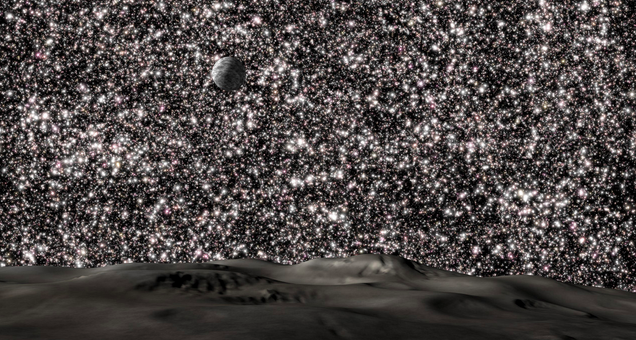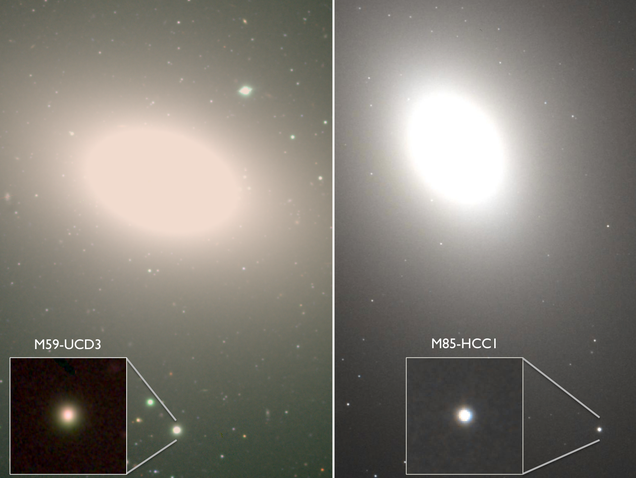
Posted on 08/04/2015 9:56:58 PM PDT by LibWhacker

Imagine what our night sky would look like if its stellar density was a million times greater than it is now. Remarkably, such places actually exist: They’re called “Ultracompact Dwarfs,” and astronomers are calling them an entirely new kind of galaxy.
Undergraduate astronomy students Michael Sandoval and Richard Vo from San José University discovered a pair of record-breaking compact galaxies buried within data contained in the Sloan Digital Sky Survey. These exotic objects are similar to ordinary globular clusters, but upwards of a hundred to a thousand times brighter.

Image: The two ultra-dense compact galaxies were discovered orbiting larger host galaxies. The systems are thought to be the remnants of once normal galaxies that were swallowed by the host, a process that removed the fluffy outer parts of the systems, leaving the dense centers behind. Image and caption credits: A. Romanowsky (SJSU), Subaru, Hubble Legacy Archive
The first system discovered, M59-UCD3, has a width that’s about 200 times smaller than the Milky Way, but with a stellar density 10,000 times greater than what we observe in our immediate galactic neighborhood. The other ultracompact dwarf, called M85-HCC1, is similar in size, but even more impressive; it features a stellar density about a million times greater than what we observe here on Earth.
“This hypercompact cluster is by far the densest confirmed free-floating stellar system, and is equivalent to the densest known nuclear star clusters,” write the researchers in their study, which now appears at the Astrophysical Journal Letters.
Needless to say, stars within UCDs are packed close together. Like, really close together.
“The typical distance between the stars in M59-UCD3 is one-quarter of a light year (20 times less than in the Earth’s vicinity), and in M85-HCC1 is 1/20th of a light year (100 times less). That’s close enough that any ‘Oort Cloud’ of comets would be disrupted,” co-author Aaron Romanowsky told io9.
In addition to the Sloan data, the researchers confirmed their observations with the Subaru Telescope, Hubble Space Telescope, and spectroscopy from the Goodman Spectrograph located on the Southern Astrophysical Research Telescope.
Exactly how the UCDs formed remains a mystery. There are three going theories: they could be (1) the remnant cores of stripped dwarf galaxies, (2) merged stellar super-clusters, or (3) compact dwarf galaxies that formed within small peaks of primordial dark matter fluctuations.
An animation showing the formation of an ultra-dense galaxy: the giant host galaxy disrupts the smaller galaxy, removing its fluffy outer parts, and the dense center is left behind. The animation then zooms in to a possible embedded planet and supermassive black hole. (Credit: M. Sandoval, A. Romanowsky (SJSU))
Researcher Michael Sandoval suspects the first theory. As he explains in a NOAO press release:
One of the best clues is that some UCDs host overweight supermassive black holes. This suggests that UCDs were originally much bigger galaxies with normal supermassive black holes, whose fluffy outer parts were stripped away, leaving their dense centers behind. This is plausible because the known UCDs are found near massive galaxies that could have done the stripping.
What’s more, these stellar objects contain an abundance of heavy elements such as iron. Large galaxies are more efficient at producing these metals, so their high metal content are a potential indication that they used to be much larger.
“These dense galaxies were not very hard to find once we knew how to look for them, so we’re going to keep looking and see how common they are,” Romanowsky told io9. “They could provide information about how many smaller galaxies were swallowed by the bigger ones—like someone eating cherries and leaving the pits behind.”
I asked Romanowsky if UCDs might be friendly to life.
“Habitability would need a careful study, but my initial thought is that M85-HCC1 in particular would be hazardous because of blasts of high-energy radiation from explosions such as supernova,” he responded. “M85-HCC1 should be forming an unusual number of exotic binary star systems including white dwarfs, neutron stars, and black holes that are prone to energetic outbursts, and when these outbursts do occur, they would be much closer by on average.”
Read the entire study at the pre-print arXiv: “Hiding in plain sight: record-breaking compact stellar systems in the Sloan Digital Sky Survey”. This study has been accepted for publication at the Astrophysical Journal Letters.
I’d be interested in the internal gravitational dynamics of these things.
Imagine what our night sky would look like if its stellar density was a million times greater than it is now.
A lot more love songs would be written! :)
They should ‘splode real good at some point.
Not a word about that in the pre-print. Don’t know where you could find out about it at this point. It’s too early, I think.
Ping

Gamma ray bursts are powerful enough to wipe out life on planets in different systems light years away. It has been theorized that a gamma ray burst caused a mass extinction here on Earth. In fact, one study estimates that life cannot exist anywhere except for the outer rims of the galaxies, because the density of the stars at the centers of galaxies increases the number of gamma ray bursts a planet will experience.
This galaxy is so dense it must be sterile.
The hippies would b*tch about light pollution.
Disclaimer: Opinions posted on Free Republic are those of the individual posters and do not necessarily represent the opinion of Free Republic or its management. All materials posted herein are protected by copyright law and the exemption for fair use of copyrighted works.